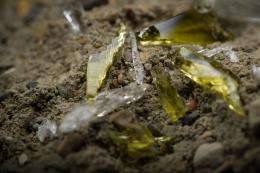Recipe for success: Recycled glass and cement

(PhysOrg.com) -- Michigan State University researchers have found that by mixing ground waste glass into the cement that is used to make concrete, the concrete is stronger, more durable and more resistant to water.
In addition, the use of glass helps reduce the amount of glass that ends up in landfills and helps to reduce carbon dioxide emissions which are common due to the high temperatures needed to create cement.
The concrete, in which about 20 percent of the cement that is used to produce the concrete is replaced by milled, or finely ground, glass, is being tested at a number of sites on the MSU campus. And, so far, the results have been pretty positive.
“Milled glass enters a beneficial reaction with cement hydrates, so basically the chemistry of the cement improves with the glass,” said Parviz Soroushian, a professor of civil and environmental engineering who has been studying the glass-concrete mix. “It makes it stronger and more durable and doesn’t absorb water as fast as regular cement.”
The test sites, which have been in existence for about three years, are located on sidewalks outside of the MSU Surplus Store and Recycling Center, south of the Breslin Student Events Center and near Fee and Hubbard halls on the east side of the campus.
“It’s satisfying to see research done in MSU laboratories have very beneficial applications right here on our campus,” said Lynda Boomer, energy and environmental engineer with the MSU Physical Plant.
The concrete doesn’t look too much different than standard concrete, Boomer said. “It’s a little lighter in color, but, for the most part, pretty indistinguishable.”
Soroushian and colleagues recently had two papers published on the durability of the mixture, including in the Journal of Solid Waste Technology and Management, and the Journal of Construction and Building Materials.
“Cement is processed at a very high temperature,” Soroushian said. “Using milled glass significantly reduces the amount of energy used, as well as CO2 emissions.”
“We anticipate that this novel practice of partially replacing cement in concrete with mixed-color waste glass, which is based on sound chemical principles and the pioneering laboratory work conducted at MSU, will yield significant environmental, energy and cost benefits,” said Roz Ud-Din Nassar, a doctoral student in civil and environmental engineering who also worked on the project.
Provided by Michigan State University










.jpg)






